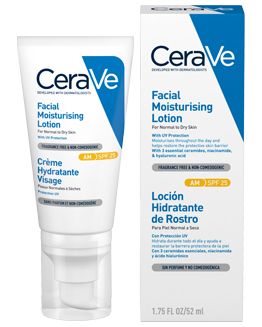 Cerave_Blog
Cerave_Blog
![]() > Clear it up Articles
> Clear it up Articles
Products for Acne-Prone Skin
A gentle, yet effective skincare regimen is essential for healthy-looking skin, especially if you're concerned about acne-prone skin condition. As the #1 dermatologist-recommended cleanser and moisturiser brand for blemish-prone skin, CeraVe offers products that help promote a clear complexion—without dryness or flaking. When used as part of a consistent acne-prone skin routine, our targeted formulas for acne-prone skin can clear blemishes, minimise the appearance of blackheads, and help prevent new breakouts from forming. Formulated with CeraVe’s three essential ceramides that help restore the skin barrier, these products help lock in moisture and do not disrupt the skin’s protective barrier.
Explore our range of products for acne-prone skin, including CeraVe’s salicylic acid blemish-control gel, niacinamide face wash, oil-free daytime moisturiser, and more.
Products you may like
-
Targeted Facial Blemish-Control Gel
Facial moisturiser for blemish-prone skin & blackheads, helping skin look noticeably clearer. The formula penetrates pores to eliminate the cause of spots & blemishes, while protecting the skin’s natural barrier.
-
Facial Moisturising Cream With SPF
A lightweight facial moisturising lotion with SPF25 for normal to dry skin enriched with 3 essential ceramides to protect the skin’s natural barrier.
-
Facial Moisturising Cream
A lightweight facial moisturising lotion for normal to dry skin enriched with 3 essential ceramides to protect the skin’s natural barrier.
FAQ Categories
Frequently Asked Questions
What causes acne-prone skin?
Clogged pores, commonly recognised as comedonal acne-prone skin variation (erupting in the form of blackheads and whiteheads), are a less severe form of skin concern, that can occur when your pores become obstructed due to oil, germs, or dead skin cells. There are many factors that can influence or potentially worsen breakouts. Examples of these include stress, humid weather conditions, air pollution, improper skincare practices (like picking at pimples), hormonal changes, and certain oily, greasy cosmetics.
Genetics may also play a role in breakouts. In other words, if a family member has struggled with pimples and blemishes, you may have a higher chance of developing them. Lastly, some research suggests a possible link between acne-prone skin and some dairy products. However, the debate amongst researchers when it comes to the relationship between acne-prone skin concerns and diet is still ongoing.
What does acne-prone skin look like?
This common skin condition can appear as a single blemish, or it can be widespread in clusters across a particular area of the body. In areas with the highest density of oil glands, the tendency for acne-prone skin to develop issues is more usual. In general, the most common locations for breakouts include the face, chest, forehead, shoulders, or upper back. Blemishes can differ in appearance depending on the type of acne-prone skin manifestation you have and how severe it is. For example, small black or brown spots known as blackheads will look different from acne-prone skin that develops large, painful lumps filled with pus beneath the skin, which are referred to as cysts in acne-prone skin.
Can I have acne-prone skin as an adult?
Contrary to what some people believe, acne-prone skin isn’t solely a teenage skin condition. Although you may be more likely to experience blemishes with acne-prone skin during puberty, these issues can occur at any age. This widespread skin issue can affect anyone, regardless of your gender, age, or ethnicity. It affects approximately 9.4% of the global population, according to research.
What are the main variations of acne-prone skin?
When caring for blemish-prone skin, it’s important to getting your skin evaluated by a dermatologist, to determine the specific condition of your acne-prone skin manifestation. The main varieties of skin breakouts according to the Cleveland Clinic, are blackheads, whiteheads, pimples (pustules), papules, nodules, and cysts.
Clogged pores, commonly recognised as comedonal issues (blackheads and whiteheads), are a less severe form of skin problem that can occur when your pores become obstructed due to oil, germs, or dead skin cells. This causes the pore to bulge, creating the appearance of dark-colored (blackheads) or light-colored (whiteheads) bumps on the skin.
How can I improve the appearance of blemish-prone skin?
Having acne-prone skin can be frustrating, but it’s important to know that you’re not alone. In fact, most people experience acne-prone skin at some point in their lives
Fortunately, acne-prone skin can be managed at home with the right skincare routine and targeted blemish-prone skin products. We recommend a daytime and nighttime regimen that includes skincare essentials like a blemish-prone skin face wash, lightweight moisturiser, and a topical blemish-control gel with ingredients like benzoyl peroxide (BPO) or salicylic acid (SA).
However, it’s important to remember that everyone’s acne-prone condition is unique, and what works for one person may not necessarily work for you. A board-certified dermatologist can help you build the right routine for your acne-prone skin condition and recommend the best acne-prone products to help you restore the appearance of clear, healthy-looking skin.
Should I skip moisturiser if I have acne-prone skin?
One of the most common acne-prone skin myths is that those with acne-prone skin should avoid using moisturiser. In truth, acne-prone skin can benefit from using a daily moisturiser just as much as any other skin type. However, to enjoy the benefits of a moisturiser, you’ll need to choose a product that’s suitable for your skin. We recommend using a ceramide-containing, oil-free daytime and nighttime moisturiser duo that’s non-comedogenic and developed with dermatologists—like CeraVe AM Facial Moisturising Lotion and PM Facial Moisturising Lotion. With MVE Delivery Technology, these non-comedogenic moisturisers can help support your skin’s moisture levels all-day and all-night long, without clogging your pores.
Which CeraVe blemish-prone skin product should I use?
CeraVe offers a range of targeted solutions for acne-prone skin. This includes our Acne Control products with 2% salicylic acid. Products with salicylic acid (such as CeraVe Blemish Control Cleanser and Blemish Control Gel) are considered especially helpful for improving the appearance of blackheads and visible pores. When used together as part of a daily regimen, our Blemish-Control range of products can help clear blemished skin, minimise visible shine, and help prevent new apparition of breakouts.
And remember: Every routine for healthy-looking skin should include a few skincare basics: gentle cleansers, non-comedogenic moisturisers, and a broad-spectrum sunscreen or moisturiser with SPF. If your skin’s appearance doesn’t improve with an at-home regimen, or your acne-prone skin is causing discomfort and interferes with your daily activities, visit a dermatologist’s office.
How does CeraVe Resurfacing Retinol Serum help acne-prone skin?
Signs of blemishes can sometimes stick around long after the blemishes have healed. These reminders of past breakouts can show up in the form of uneven skin tone and post-acne prone skin marks (also known as post-inflammatory hyperpigmentation). CeraVe Resurfacing Retinol Serum is designed to help smooth your skin's texture, reduce the appearance of post-acne marks, and minimise the look of pores. This makes it a great facial serum for anyone looking to restore an even skin tone and promote a healthy-looking complexion.
What’s the main ingredient in CeraVe’s Blemish Control products?
The main active ingredient in CeraVe’s Blemish Control products is salicylic acid. This beta-hydroxy acid (BHA) provides gentle exfoliation and is great for helping improve the appearance of enlarged pores, whiteheads and blackheads. Our Blemish-Control range with 2% salicylic acid includes two core products: CeraVe Acne Control Cleanser and CeraVe Acne Control Gel. When used together as part of a consistent acne-prone skincare routine, these products can help reduce blackheads, improve the look of pores, and help prevent new breakouts. They also feature CeraVe’s three essential ceramides, which lock in moisture and help maintain the skin’s protective barrier.
References
- Meixiong J, Ricco C, Vasavda C, Ho BK. “Diet and acne: A systematic review.” JAAD Int. 2022 Mar 29;7:95-112. doi: 10.1016/j.jdin.2022.02.012. PMID: 35373155; PMCID: PMC8971946.
- Pappas A. “The relationship of diet and acne: A review.” Dermatoendocrinol. 2009 Sep;1(5):262-7. doi: 10.4161/derm.1.5.10192. PMID: 20808513; PMCID: PMC2836431.
- Tan, J K L, and K Bhate. “A global perspective on the epidemiology of acne.” The British journal of dermatology vol. 172 Suppl 1 (2015): 3-12. doi:10.1111/bjd.13462.
- “Skin Conditions by the Numbers.” American Academy of Dermatology Association, 2023.
- “Acne: Types, Causes, Treatment and Prevention.” Cleveland Clinic, 2023.


